OSO-7
Orbiting Solar Observatory-7
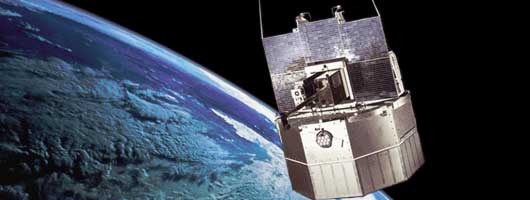
Cosmic X-ray Experiment
Detector | Electronics | Particle Monitors | Response | Background
Although the interaction of a high energy photon with a scintillation counter telescope can be extremely complex, this detector has simple response in the 10-100 keV range, where galactic emission is strong. The detector is directly sensitive to the passage of ionizing particles, which photons produce either by photoelectric ejection of atomic electrons, by Compton scattering, or by pair production once beyond the 1.022 MeV threshold. Photoelectric interactions usually result in the deposit of all the energy of the photon in the crystal, a few percent being converted into the light viewed by the photomultiplier tube. The main complication is the possibility (<25% chance in a thick detector) that accompanying atomic x-rays may escape from the crystal, which would reduce the energy deposit detected by the energy of the corresponding atomic transition. In practice, only iodine K x-rays have a significant chance of escaping from the central detector, thus producing an inferred energy 28.5 keV less than that of the original photon.
The scattered photon resulting from a Compton interaction can have high energy, however, and may escape the central crystal. If this occurs, the pulse height in the detector will range from zero (for forward scattering) to 2E2/(m+2E) for a backscattered event, where E is the incident photon energy and m=511 keV. An important feature of the active anticoincidence design is that most Compton scattered photons interact in the shield counter and are vetoed. Calculations of exact escape probabilities are very complicated, and Monte Carlo programs are used to model instrument response to arbitrary precision.
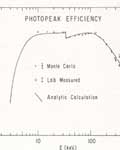 The response of the detector may be most completely described by the detector response function G(E',E), defined so that if a beam of No photons of energy E is incident, the number of expected counts between E' and E'+dE would be NoG(E',E)dE. If G is expressed in terms of finite energy channels (i.e., the PHA channels), the result is the detector matrix Gij, a form particularly useful for computer calculations.
The response of the detector may be most completely described by the detector response function G(E',E), defined so that if a beam of No photons of energy E is incident, the number of expected counts between E' and E'+dE would be NoG(E',E)dE. If G is expressed in terms of finite energy channels (i.e., the PHA channels), the result is the detector matrix Gij, a form particularly useful for computer calculations.
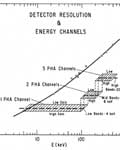 In practice the energy measured by the PHA will not be the same as the energy deposited. The major source of variation is usually due to statistical fluctuations in the number of photoelectrons produced at the photocathode of the photomultiplier tube. The variance due to this process is proportional to the energy of the event. Non-uniform light collection from across the width of the detector is another source. An event near the edge of the crystal will produce a pulse height 30% smaller than one in the center. The ability to infer the energy of the incident photon as a function of energy is the energy resolution and is characterized as delta E/E (FWHM).
In practice the energy measured by the PHA will not be the same as the energy deposited. The major source of variation is usually due to statistical fluctuations in the number of photoelectrons produced at the photocathode of the photomultiplier tube. The variance due to this process is proportional to the energy of the event. Non-uniform light collection from across the width of the detector is another source. An event near the edge of the crystal will produce a pulse height 30% smaller than one in the center. The ability to infer the energy of the incident photon as a function of energy is the energy resolution and is characterized as delta E/E (FWHM).
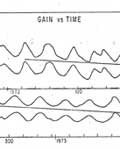 The connection between the PHA channel measured and the incident energy deposited in the central detector is generally a linear function with offset and gain as the parameters. These values are determined from fitting x-ray line energies from known radioactive sources, such as Fe-55, Cd-109, Co-57, Hg-203, and Na-22, before launch. Once in orbit, variations in the gain and offset, if any, are inferred from measurements of spectral features in background spectra. The gain varied from 5 keV/channel early to 3.7 keV/channel near the end of the mission. The offset remained constant at 2.68 channels.
The connection between the PHA channel measured and the incident energy deposited in the central detector is generally a linear function with offset and gain as the parameters. These values are determined from fitting x-ray line energies from known radioactive sources, such as Fe-55, Cd-109, Co-57, Hg-203, and Na-22, before launch. Once in orbit, variations in the gain and offset, if any, are inferred from measurements of spectral features in background spectra. The gain varied from 5 keV/channel early to 3.7 keV/channel near the end of the mission. The offset remained constant at 2.68 channels.
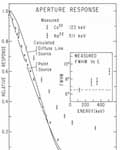 Below 200 keV the CsI shield was very effective in stopping non-aperture photons, so the telescope's directional properties were determined by the collimator. The response as a function of angle to point and diffuse line sources was estimated by a geometrical calculation. It was compared to laboratory measurements with various sources at a distance of 10 meters. The tail of the distribution at large angles for the 22Na 511 keV radiation is partly due to Compton scattering in the air between the source and the detector, as well as leakage through the collimator walls.
Below 200 keV the CsI shield was very effective in stopping non-aperture photons, so the telescope's directional properties were determined by the collimator. The response as a function of angle to point and diffuse line sources was estimated by a geometrical calculation. It was compared to laboratory measurements with various sources at a distance of 10 meters. The tail of the distribution at large angles for the 22Na 511 keV radiation is partly due to Compton scattering in the air between the source and the detector, as well as leakage through the collimator walls.
OSO-7 Information
Mission Objectives
Spacecraft
Cosmic X--ray Experiment
Solar X--ray Experiment
Results
Publication